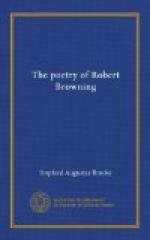Poet, Characteristics of a
Poetry
Grounds of Judgment on
Characteristics of Best
Form in
Matter in
Thought and Emotion in
Portraiture, Browning’s Power of Minute
Prelude, The (Wordsworth)
Princess, The (Tennyson)
Promise of May, The (Tennyson)
Purgatorio, The (Dante)
Q
Queen Mary (Tennyson)
R
Racine
Realism in Browning
Religious Phases, Poems dealing with
Renaissance, The
Renaissance, Poems dealing with the
Renan
Revenge, The (Tennyson)
Ring and the Book, The
Nature-description in
Its Position among Browning’s Works
Its Plan
Humour and Wit in
Partly intellectual, partly imaginative
Study of Renaissance in
Scenery and human Background
Browning’s imaginative Method in
Minor Characters in
Principal Characters
Guido
Caponsacchi
Pompilia
The Pope
The Conclusion
Rizpah (Tennyson)
Robin Hood (Tennyson)
Romantic Spirit in Browning
Rossetti
Ruskin
S
St. Simeon Stylites (Tennyson)
Scott
Shakespeare
Shelley
Sir Galahad (Tennyson)
Sordello
Landscape in
The Temperament of the Hero
His artistic Development
The Argument
Historical Background to the Story
Nature Pictures
Portraiture
Illustrative Episodes
Analogy between Sordello and Browning
Theory of Art in
Theory of Life in
Character of the Heroine
Style in Browning
Swinburne
T
Tempest, The (Shakespeare)
Tennyson
Turner
Theory of Life, Browning’s
Its main Features
In Pauline
In Paracelsus
In Easter Day
In Abt Vogler
In Andrea del Sarto
In Old Pictures in Florence
In Sordello
V
Vergil
Vita Nuova, La (Dante)
W
Will Waterproof’s Monologue (Tennyson)
Womanhood, Studies of
In the Early Poems
Pauline
Lady Carlisle
Palma
In the Dramas, &c.
Ottima
Pippa
Anael
Mildred and Guendolen
Colombe
Constance
In the Dramatic Lyrics
Characteristics of Browning’s Women
Poems to Mrs. Browning
Pompilia
Balaustion
Womanhood in the Modern Poets
Wordsworth



